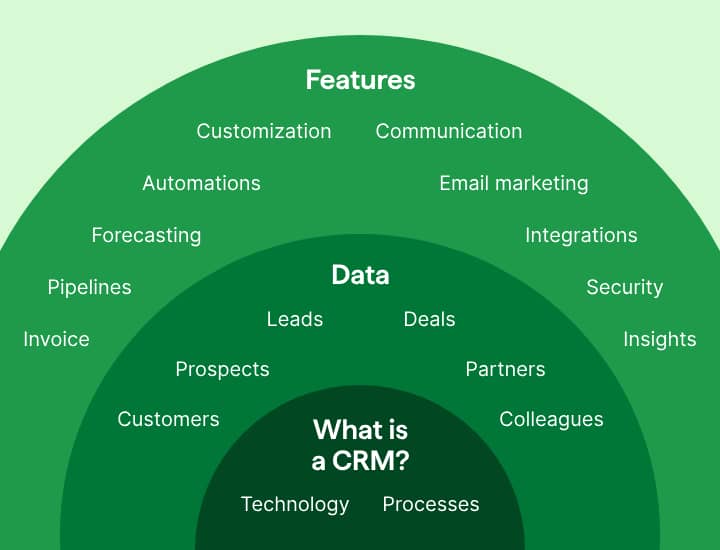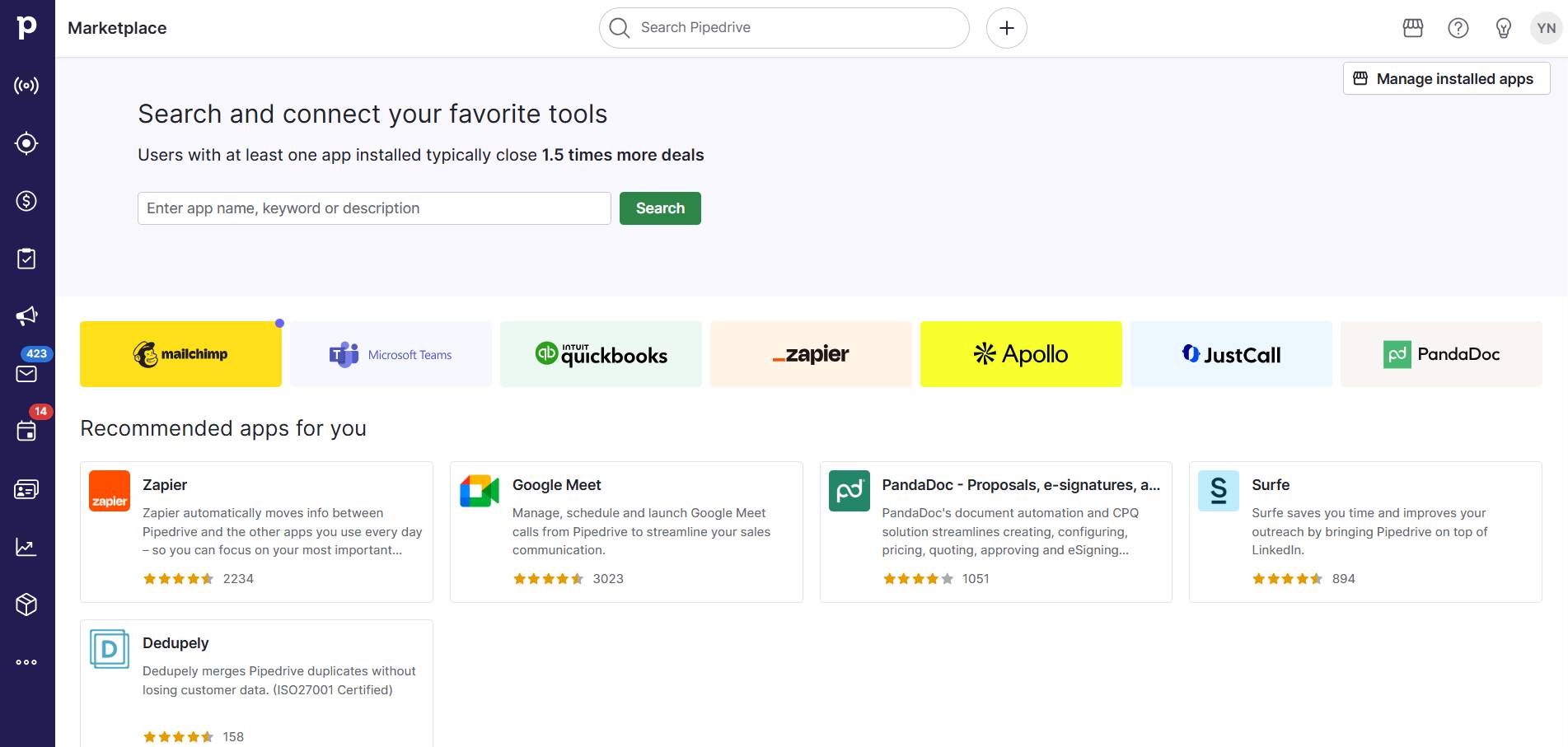Life sciences companies face growing pressure as managing HCP relationships, patient data and compliance becomes increasingly complex.
A CRM built for the life sciences industry turns these challenges into opportunities by connecting every stakeholder and automating critical workflows.
In this article, you’ll learn how life sciences CRMs help SMBs streamline operations, optimize engagement and deliver patient-centric results while staying compliant and ready to scale.
Key takeaways for CRM in Life Sciences
A CRM in life sciences helps SMBs manage compliant, data-driven relationships with HCPs, HCOs and patients.
Automation tools and connected workflows reduce manual effort, helping teams focus on patient care and stakeholder engagement.
Integrations across marketing, communication and reporting systems create a unified ecosystem that supports end-to-end visibility and compliance.
Pipedrive gives life sciences teams a simple, scalable way to stay organized. Try it free for 14 days.
What is a CRM in life sciences?
CRM in life sciences is a customer relationship management (CRM) system that biotech, pharmaceutical, medical device and diagnostics companies use to track customer interactions and ensure regulatory compliance.
Unlike a general or sales-focused CRM platform, it helps teams manage fewer but more important relationships with healthcare professionals (HCPs), healthcare organizations (HCOs) and patients while staying compliant with strict rules.
For small and mid-sized life sciences companies, the right CRM gives a clear view of customer engagement without adding extra complexity.
The system links sales, marketing and patient support teams through automation and secure data sharing.

The right platform can also ensure shared data complies with the Health Insurance Portability and Accountability Act (HIPAA), the General Data Protection Regulation (GDPR) and other local privacy laws.
For example, a general CRM might track a sales rep’s meetings and email history. A life sciences CRM adds layers like approved content sharing, adverse event reporting and audit-ready records to meet healthcare regulations.
A CRM in the life sciences industry brings people, data and workflows together. It helps companies manage outreach, support key opinion leaders (KOLs) and improve engagement strategies across every channel while keeping compliance simple.
Why CRM matters for life sciences
CRMs in the life sciences industry are essential for managing every relationship that drives growth.
Gartner highlights that traditional CRMs, which focus solely on sales force automation, no longer meet the outreach needs of life sciences companies.
Modern life sciences companies need connected, data-driven systems that help them engage HCPs, HCOs and patients with accuracy and trust.
Why it matters:
Regulations, privacy laws and regional rules make it hard to manage data across markets without a connected system
New digital tools like telehealth, artificial intelligence (AI) and mobile apps have raised expectations for real-time, personalized engagement
Silos between marketing, sales and medical teams limit collaboration and reduce the impact of every customer touchpoint
A modern CRM built for life sciences brings all of this together.
For example, a medical device company can use a CRM to connect its sales and support teams, enabling them to share product training sessions, maintenance logs and customer feedback automatically.
This transparency helps sales reps understand usage patterns and allows service teams to anticipate needs. It also ensures compliance teams can track every interaction from a single, verified record.
Turn Maybe Into Yes With These Killer Follow Up Email Templates
What are the core features to look for in a life sciences CRM?
Small and mid-sized companies need CRM tools that simplify complex work without adding extra cost or heavy infrastructure.
Unlike enterprise systems built for global pharma, SMBs benefit most from flexible, easy-to-use CRMs that still meet strict compliance and data security standards.
The goal is to balance functionality with efficiency so teams can focus on building strong HCP and patient relationships rather than managing technology.
Below are some of the key features to look out for:
CRM feature | Why it matters |
Compliance and security | Keeps sensitive patient and HCP data protected and can help meet HIPAA and global privacy laws. |
HCP and KOL management | Tracks key relationships, interactions and preferences to support more targeted outreach. |
Segmentation and targeting | Helps tailor campaigns and messages to specific HCP, HCO or patient groups. |
Omnichannel communication | Connects email, video and in-person touchpoints so every interaction stays consistent. |
Analytics and dashboards | Provides real-time insights for better decision-making and performance tracking. |
Integration with Enterprise Resource Planning (ERP) and marketing automation | Reduces data entry, aligns commercial operations and improves reporting accuracy. |
For SMBs, these features create a powerful yet practical foundation for growth. A well-chosen life sciences CRM turns daily operations into connected workflows, making it easier to engage customers without adding complexity.
Pipedrive in action: Serenis, an online mental health platform, used Pipedrive to stay connected with patients and therapists as the company grew.
By automating workflows and improving team visibility, Serenis reduced admin work and delivered a more personal care experience. Read the full case study to see how they scaled faster with Pipedrive.
How a CRM supports sales, marketing and patient engagement
For SMBs in life sciences, a CRM helps sales reps, marketers and patient support teams work together using the same data and insights.
This alignment makes it easier to deliver consistent, high-quality experiences for HCPs and patients and make data-driven decisions.
Let’s take a closer look at some specific use cases across a life sciences organization.
Sales teams: tracking visits and building stronger HCP relationships
Sales in life sciences are built on trust, not transactions.
A CRM helps reps manage complex HCP relationships, track visits and follow up at the right time without missing key details.
It keeps all meeting notes, emails and approved content in one place so teams can stay organized.
For example, a biotech sales rep can review a doctor’s history, plan the next visit and log outcomes all from the same dashboard.
How a CRM helps sales teams:
Tracks HCP interactions, field visits and sample deliveries in real time
Automates reminders and follow-ups for faster, more consistent outreach
Keeps all communication and materials compliant with industry standards
Shows past activity so reps can personalize each visit and build stronger relationships
Tip: Use Pipedrive’s automation and field sync features to follow up with leads faster and spend more time engaging HCPs.
Marketing teams: delivering targeted campaigns for HCPs and patients
Marketing in life sciences relies on precision and compliance.
A CRM helps marketing teams segment audiences, manage consent and send approved content through the right channels. It ensures every campaign aligns with regulatory standards while still feeling personal and relevant.
For example, a biotech company launching a new therapy can use its CRM to segment HCPs by specialty, region and prescribing history. It can then deliver custom messages to help each segment understand how the new therapy meets their specific needs.
For smaller life sciences companies, this means marketing can move at the speed of digital without risking compliance.
How a CRM helps marketing teams:
Segments HCPs, HCOs and patients based on specialty, region or engagement history
Automates email campaigns and event outreach with pre-approved materials
Tracks engagement and feedback across channels to refine future campaigns
Connects marketing data with sales insights for a complete view of performance
Tip: Align marketing workflows with your compliance team before launching a campaign. Building approved templates and automated review steps into your CRM keeps outreach fast and consistent.
Patient support programs: improving adherence and communication
A CRM helps teams manage support programs, track progress and communicate with patients in ways that feel personal.
For example, a pharma company running a treatment adherence program can use a CRM to schedule check-ins, log outcomes and flag potential follow-up needs.
How a CRM helps patient support teams:
Tracks each patient’s progress and touchpoints through the full care journey
Automates reminders for medication, appointments or follow-up communication
Stores notes and data securely to maintain HIPAA compliance
Gives teams visibility into patient outcomes for better support and insights
Tip: Use your CRM to centralize patient communication. A single source of truth helps teams coordinate faster, reduce confusion and create a smoother patient experience.
Operations: keeping reporting accurate and compliance-ready
Operations teams are the backbone of any life sciences organization.
They handle the data, documentation and reporting that keep everything running smoothly.
A CRM helps teams collect and organize information from every department, ensuring that compliance reports, audits and performance reviews are quick and reliable.
For example, a medtech company can use a CRM to track device distribution, document adverse events and generate ready-to-share reports for regulators.
How a CRM helps operations teams:
Centralizes data from sales, marketing and patient programs for consistent reporting
Automates audit trails and documentation for faster compliance checks
Tracks adverse events and medical inquiries to ensure issues are resolved quickly
Provides dashboards that give real-time insight into commercial operations and performance
Tip: Try Pipedrive’s automated reporting templates and shared dashboards to simplify compliance checks and ensure consistent performance data.
Disclaimer: In the United States, any system that handles protected health information must meet HIPAA standards. Pipedrive isn’t HIPAA compliant, so you shouldn’t store patient names, medical details or other sensitive health information in the platform.
For SMBs in the life sciences, teams need a platform that’s simple enough to use every day yet powerful enough to manage complex relationships, workflows and compliance requirements.
Pipedrive offers that balance by providing growing life sciences organizations with the tools to connect with HCPs, HCOs and patients while keeping operations lean and compliant.
Let’s look at some ways Pipedrive helps bring structure, insight and workflow automation to life sciences engagement.
1. Create a unified view of HCP and patient relationships
Keeping track of every relationship is one of the most challenging parts of working in life sciences.
Pipedrive solves this by giving teams one place to see every interaction, note and follow-up in a clear, visual pipeline.
When a new contact is added, Pipedrive stores all communication history, meeting details and documents in a single view.
You can see how to set up a sales pipeline in this video:
Customizing pipelines makes it easy for anyone on the team to understand the full relationship before the next interaction.
Filters and custom fields help segment contacts by specialty, region or engagement type so teams always know where each relationship stands.
Note: While Pipedrive is ideal for managing relationships with healthcare organizations (HCOs) and professionals (HCPs), it shouldn’t store protected patient data.
For companies that manage patient programs, we recommend integrating Pipedrive with a HIPAA-compliant patient management or EHR system to securely handle sensitive information.
2. Automate for compliance and follow-ups
With Pipedrive, everyday admin tasks like assigning new leads, scheduling calls and logging follow-ups happen automatically.
Automation helps smaller life sciences companies stay efficient while maintaining accurate records for compliance and reporting.
When someone shows interest in your services, Pipedrive’s Leads Inbox captures their details so your team can respond quickly.
Here’s a deeper look at using Leads Inbox:
Using LeadBooster or custom API tools, new customers or patients appear instantly, triggering the next steps, such as assigning a consultant or scheduling a call.
You can also tag contacts with labels like “Clinic” or “Hospital buyer” to make sorting and follow-up easier.
The Advanced Stem Cell Institute is a great example of automating follow-ups.
The clinic used Pipedrive to connect sales, scheduling and patient communication in one platform. By doing so, it’s been able to reach out to about 25 more patients per day and boost conversions.
According to Erez Illouz, Treatment Coordinator and Regenerative Medicine Consultant:
"Once we’ve scheduled a patient for a consultation, our conversion rate is 68%. Some patients do not qualify past this point. For the ones that do, after they have received their treatment recommendations our conversion rate is 89%.
This could not be done without Pipedrive helping us sort our leads, automatically schedule activity reminders and keep our staff on track to not lose any details for each patient during the process.”
3. Connect to your existing marketing and communications tools
For life sciences companies, the real power of CRM lies in its ability to integrate seamlessly with other systems.
Sales, marketing and operations teams all rely on different tools, such as email marketing platforms, patient management software or documentation tools.
Without integrations, data stays siloed and teams waste time switching between apps or duplicating work.
Pipedrive’s Marketplace offers hundreds of integrations that simplify this process.

Teams can connect their CRM with tools they already use for marketing, automation and communication without complex development.
Popular integrations for life sciences teams include:
Zapier for connecting patient care management or scheduling systems
Google Workspace for syncing calendars, emails and meeting notes
QuickBooks for handling invoice creation and tracking
The benefits of this approach are clear in the story of Eye Hospital Denmark.
The hospital used Pipedrive integrations to connect its CRM with patient journal systems, automate reminders and link marketing tools.
These integrations helped reduce appointment no-shows by 50% and eliminated errors in lens ordering, achieving a 0% failure rate.
As Kristian Mejlvang, Eye Hospital Denmark’s Marketing Manager, explained:
“We chose Pipedrive because of its intuitive, clever design, its simple UI and lead generating abilities. Pipedrive is not a heavy system: unlike Salesforce or Microsoft Dynamics 365, Pipedrive is easy to use and has a simple approach to building activities.
Being part of the health/medical industry, the system is suitable because it allows us to connect to several other vital systems, such as patient journal systems.”
What are the challenges of implementing a CRM in life sciences?
CRM solutions can transform how life sciences companies operate, but they also present a few challenges to plan for.
Understanding these risks helps teams set realistic expectations, choose the right tools and avoid common roadblocks during rollout. Here are some of the top concerns to be aware of:
High upfront cost. While modern CRMs like Pipedrive offer affordable pricing, setup and customization can still require time and budget. Smaller life sciences companies may have to balance investments in software with training and compliance needs.
User adoption barriers. If teams view a CRM as extra work instead of support, adoption rates tend to fall. Training and clear workflows are key to showing value early.
Integration with legacy systems. Many life sciences organizations still rely on older patient or ERP systems. Connecting these securely to a new CRM can be complex without API support or integration tools.
Evolving regulatory requirements. Data privacy laws like HIPAA and GDPR change often. CRMs must adapt quickly so organizations can maintain compliance without the need for constant manual checks.
Data quality issues. Inconsistent or outdated information weakens the CRM’s impact. Clean data management and regular audits help ensure accurate insights and trustworthy reports.
By addressing these challenges early, SMBs in the life sciences industry can build a CRM system that works smoothly, supports compliance and enhances the customer experience.
Final thoughts
With the right CRM, small and medium-sized life sciences companies can simplify workflows, stay compliant and build stronger relationships that drive lasting growth.
Pipedrive gives your team a simple, scalable way to manage outreach, automate follow-ups and track results across every touchpoint. Try Pipedrive free for 14 days.






